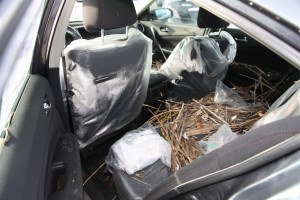Hurricanes and tropical storms affect more than just homeowners. Following Superstorm Sandy, which hit October 28, 2012, insurance companies processed more than 250,000 claims for damaged vehicles. Damage can range from scratches and minor dents to vehicles being crushed or flooded.

“Rising water can cause major damage to the vehicle,” said Bob Passmore, Property Casualty Insurers Association of America’s senior director of personal lines. “Water damage to a vehicle is typically covered under an auto policy’s comprehensive insurance coverage.”
Consumers and adjusters should be wary of vehicles that are exposed to flood waters. Unfortunately, there are many instances of flood damaged vehicles being resold to uninformed buyers. According to the National Insurance Crime Bureau (NICB), dishonest car dealers can purchase flooded cars, clean them up and sell them with hidden damage. They then can transport the damaged cars to states that were unaffected by the storm, and then sell them without disclosing the vehicles true history.
What to look for in a washed up vehicle
The NICB outlines specific things to be on the look out for:
• Inspect the vehicle for water stains, mildew, sand, or silt under the carpets, floor mats, headliner cloth and behind the dashboard.
• Check for recently shampooed carpet.
• Inspect the interior upholstery and door panels for fading.
• Check for rust on screws in the console or areas where water normally doesn’t reach.
• Check for mud or grit in the spare tire compartment, alternator crevices, behind wiring harnesses, around the small recesses of starter motors, power steering pumps and relays.
• Check inside the seatbelt retractors by pulling the seatbelt all the way out and inspect for moisture, mildew or grime.
• Check door speakers as they will often be damaged due to flooding.
• Ask about the vehicle’s history. Ask whether it was in any accidents or floods.
• Inspect the title and ownership papers for any potential or questionable salvage fraud.
• Conduct a title search of the vehicle.
• Look under the hood for signs of oxidation. Pull back rubber boots around electrical and mechanical connections for these indicators: Ferrous materials will show signs of rust Copper will show a green patina.
• Aluminum and alloys will have a white powder and pitting.
Source: PCI
Was this article valuable?
Here are more articles you may enjoy.

 Standard Chartered Settles $2 Billion Iranian Sanction Suit in London
Standard Chartered Settles $2 Billion Iranian Sanction Suit in London  State Farm Sued Over Policies Backed by Distressed Insurer PHL
State Farm Sued Over Policies Backed by Distressed Insurer PHL  ‘Dream Is in Sight:’ Chamber, Reinsurers, Insurers Urge Florida to Stay the Course
‘Dream Is in Sight:’ Chamber, Reinsurers, Insurers Urge Florida to Stay the Course  Hermès Heir Sues Arnault and LVMH in $16 Billion Suit Over Lost Shares
Hermès Heir Sues Arnault and LVMH in $16 Billion Suit Over Lost Shares 